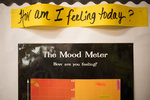Forget mood rings, PS 95 touts its own mood meters
It’s not just about doing well at P.S. 95 Sheila Mencher, it’s feeling well, too.
This state weaved stronger mental health approaches into its health class curriculum this past fall. But at the Hillman Avenue school, mental health always has been on the meter — figuratively and literally speaking.
Students communicate their feelings throughout the day by moving their personalized figure on the classroom mood meter. There are four main emotions — happy, sad, angry or calm — represented by different colors. The way a student feels, however, can range beyond that.
“I pulled him aside and asked him why he put his name in the red and he said that he was worried,” said Isabel Prieto, a general education teacher, about her recent interaction with a student using the meter. “And I said, ‘What are you worried about?’ We have some students who have food insecurities, and his mom forgot to pack him a snack, and he was distracted by that until I was able to secure that snack.”
The meter requires students to update their mood twice daily. However, if a student feels inclined to change his or her mood more often, it’s encouraged. The meter is especially useful in special education classes, helping children prone to meltdowns among other issues work through their emotions.
“Usually we handle the after effects, but with the mood meter, they get to place themselves with their feelings,” special education teacher Megan Gradotzke said. “If they see a classmate in the red, they know to give them space. Or if they see a classmate in the blue, they may ask what’s wrong.”
Paired with what she calls her “calm down corner,” Gradotzke has developed strategies for working with her students.
“I’ll talk to them, take them aside and the mood meter is a good way to see how they’re feeling,” she said. “They’re letting you know without them having to say it, and it’s a way for them to let everyone know how they’re feeling.”
Separating home life from school life is next to impossible for students, Gradotzke said, and it’s important teachers acknowledge the feelings that didn’t form in the classroom.
“Their being upset is going to affect their day, and they feed off of each other,” she said. “It’s also about developing strategies to deal with their feelings. These kids have backgrounds you may not know about. Some may be living in shelters or parents are fighting every day.”
P.S. 95 has incorporated social and emotional well-being into their curriculum for more than two years now. But it wasn’t until this past summer the rest of New York officially caught up.
According to the Journal of the American Academy of Child and Adolescent Psychiatry, more than 22 percent of teenagers suffer from mental illness.
In addition, 50 percent of mental illness begins at 14, according to the American Psychiatric Association.
“It’s a valuing importance, thinking of soul, body and mind, and we want our students to have a great sense of self,” said P.S. 95 principal Serge Davis, who sent teachers to Yale University to learn about their study approach focusing on education, and social and emotional development.
At P.S. 95, the goal is not only to make sure students are doing well on a social-emotional level, but also acclimate them to speaking about their thoughts and feelings. When other kids put their mood figures on negative emotions, “We help them,” said Alana Lopez, a first-grader.
“Sometimes they want what they want to do because they’re frustrated,” Lopez said. “I tell them to take a deep breath and breathe it out.”
“I think the mood meters are good,” said Mozel Holmes, a fifth-grader. “I like that it has more choices because it has more details and more of a range in the topics.”
Their mood meter icons are just as personal as their actual feelings. The figures range from small wooden cutouts the children decorated that reflect themselves to animals they like. Ethan Rosas’ figure is a Minion from the film “Despicable Me.” And for Ivonne Sanchez, a panda.
“I feel calm because I did my homework,” said Sanchez, a first-grader, whose mood meter was in a good place this particular day. “In the afternoon, I feel happy because I get to see my teacher today.”
For Rosas, he felt proud because he had just finished reading in class.
At the base of it all, students just want to feel safe, Prieto said, whether that means having a snack in their lunchbox or just knowing who’s going to pick them up after school.
“It’s not just about the education of the child,” said assistant principal Daniela Savino. “Children come in with complex lives, and navigating that through school can sometimes be difficult.”

















